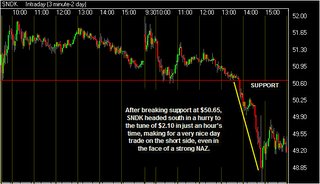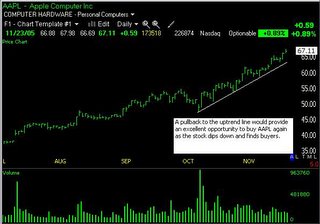Convenience is a driver of our society, as well as trading. Every trading publication seems to have advertisements offering an easier way to trade. The most convenient way to trade is through a direct access brokerage. In fact, if you aren’t trading through a direct access brokerage, you should be.
Having traded in day trading firms for several years, I have grown quite accustomed to trading through a software application rather than placing orders on a broker’s website. My platform of choice is the CyberTrader Pro platform which I've been using for over 2 years, and it offers me everything I need all in one place. I have multiple chart windows, watch lists, level 2 quotes, news headlines, real-time position P&L, trade alerts, and many other bells and whistles which are important to my trading style.
My favorite feature of trading with such a platform is that I can enter orders with a single keystroke. I set up hotkeys to route my orders through different venues, such as ECN’s like ARCA or INET, and separate market orders from limit orders. This way, when I locate a trade, I can hit one key and buy or sell with the push of a button. Particularly with Nasdaq stocks, I usually have the shares in my account by the time my finger comes off the hotkey, it literally is that fast. The number pad on my keyboard has different share sizes assigned to each number, so I can also easily adjust my lot size if my default is different than what I wish to trade. Hitting the ESC key will cancel my order. This is way faster than a browser-based order entry which requires new pages to load or refresh while waiting for confirmation of a fill or cancel. While I use
trading alerts to automatically place orders for positions I intend to hold, hotkeys give me incredibly fast fills on discretionary trades like day trades. If you aren’t using hotkeys, you’re a step behind.
Hotkeys also allow me to “scalp” with ease, day trading stocks for small intraday moves. Direct access also usually offers commission pricing plans on a per-share basis, rather than per trade. This has saved me untold thousands of dollars, and has allowed me to trade much more frequently when the market is moving. While I prefer
swing trading, the cheap commissions and instant order placement lets me employ a
day trading strategy to capture intraday moves. This is a nice alternative on days when my overnight positions are not moving much, but when I still find opportunity (such as a trading range or
channeling stock).
My trading platform allows me to constantly monitor my account value, my P&L for the day, and how much buying power I’ve used and have remaining. I also can see exactly how much commission I’ve spent, how many shares I’ve traded, the market value of open positions in relation to my account, the long market value and short market value of open positions, and many more stats.
If you’re a full-time or very active trader, I highly encourage you to convert to a direct access trading platform such as CyberTrader Pro or something similar. You’ll likely enjoy cheaper commissions, faster order entry and fills, and many more tools at your fingertips designed to make your trading better. I can’t imagine going back to a browser or web-based trading method! It would make the already tough game of trading more difficult.
Jeff White
President, TheStockBandit.com
www.thestockbandit.com


